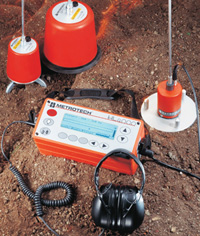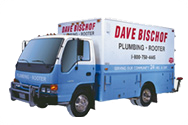Spectrum Analyzing Digital Electronic Leak Detection
Leak detection instruments amplify sounds in the 200-2000 MHz range. They do not “find leaks” anymore than a stethoscope diagnoses illnesses. By using highly specialized microphones contacting hard surfaces, acoustic signatures can be analyzed. But mere possession of the best equipment doesn’t make one competent anymore then buying a scalpel makes on a surgeon.
Few plumbing firms actually have leak detection equipment. Most just advertise it and subcontract it out. Both tend to use the old fashioned analog detectors.
We use not outdated analog detectors but the finest MetroTech spectrum analyzing digital electronic leak detection instruments. With the MetroTech digital instruments we can analyze acoustic signatures and filter out superfluous sounds and view the signature over a timeline.
Procedure Overview
The first step we perform is determining if the diagnostic procedure is even warranted. Many clients request leak detection services and we determine the procedure and costs are not needed. If after isolation metering tests and an inspection reveal that spectrum analyzing leak detection services are indicated, we commence by conducting a brief client interview to obtain and formulate a history of their potable water distribution, repair and leak history. Excellent clues can be obtained this way.
 Next a contact microphone is used to touch the exposed appurtenances of the water distribution system such as emergency water shutoffs, shower valves or other exposed tubing. If these are not available, then we use ground-based microphones. If a strong acoustic signature cannot be obtained such as the leak is intermittent or too small, then gas ingestion via a compressed cylinder may be warranted. Once we have a target acoustic signature, we use our MetroTech instruments to analyze the frequency spectrum and usually we then filter out all but the strongest signature.
Next a contact microphone is used to touch the exposed appurtenances of the water distribution system such as emergency water shutoffs, shower valves or other exposed tubing. If these are not available, then we use ground-based microphones. If a strong acoustic signature cannot be obtained such as the leak is intermittent or too small, then gas ingestion via a compressed cylinder may be warranted. Once we have a target acoustic signature, we use our MetroTech instruments to analyze the frequency spectrum and usually we then filter out all but the strongest signature.
In preparation to excavate through the concrete slab, it is often prudent to diamond saw through or score the concrete so our larger electric jackhammers do not create or propagate concrete fractures past the perimeter of the excavation.
Prior to excavation, we often times dust bag off the area. This protects our client’s home and demonstrates our level of care. A secondary alternative dust control method is using a large industrial vacuum with a new dust filter installed, and an assistant sucks the dust generated by the concrete saws and jackhammers.
Repairs usually involve use of high-temperature silver brazing materials and techniques, as most codes prohibit use of low-temperature common plumbing solders. Additionally, in buried potable water pipes disinfecting water lines that have sucked in unsanitary earth requires that a disinfection protocol be used which is routine for us.
After the repair is effected, a test is performed and the small excavation is backfilled usually with sand so that no sharp rocks are touching the soft copper tubing.
If in our professional opinion the cause of the leak was as a result of negligence of the original installer, we may advise you on statues of limitations issues in an attempt to assist you in getting reimbursement from the original installer, although normally standard homeowners insurance covers the majority of this repair procedure.
You are terrific. It helps us so much to have trustworthy help from afar.
– Mark & Kris Ammons

1-800-750-4445
